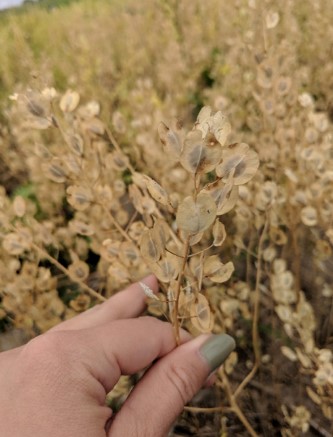By Sarah Moore, M. Scott Wells.et.al
Thirty-seven percent of sweetcorn in the US is produced in the upper Midwest. In order to meet quality standards, sweetcorn requires high nitrogen fertilization. It is also harvested as a fresh vegetable rather than a grain, meaning there is a large quantity of nitrogen in the residue that is left on the field after harvest. As a result, sweetcorn systems are particularly susceptible to nitrogen loss. Planting a cover crop after sweetcorn can help to keep this nitrogen in the field and out of waterways. Additionally, sweetcorn is harvested earlier than grain corn, allowing more time in the fall for a cover crop to establish and grow. However, cover crop adoption is low in the upper Midwest due to a lack of incentives. Outside of forages, such opportunities for cover crop profits are limited.

Research at the University of Minnesota through the Forever Green Agricultural Initiative program envisions pennycress as a new winter annual oilseed crop that can provide all the ecosystem services of a cover crop, such as reducing erosion and nitrogen loss, while also being harvestable for profit (For more information:
https://z.umn.edu/pennycress). The research addressed three main questions: Can pennycress sequester nitrogen after sweetcorn? Does the amount of fertilizer applied to sweetcorn affect pennycress yields? Will pennycress planting method impact pennycress yield or the ability of pennycress to sequester nitrogen?
Methods: Sweetcorn was planted in June with fertilizer applied pre-plant as urea, then harvested in August and sweetcorn stalks were chopped and left in the field. Pennycress was planted directly into the sweetcorn stover in September using two seeding methods, broadcast and drilled, and harvested at maturity the following June. Soil samples and pennycress biomass samples were taken in the fall, the spring, and the summer, and used to calculate sequestered nitrogen.

Results: Regardless of pennycress planting method or nitrogen rate applied to sweetcorn, pennycress sequestered approximately 17 lb/ac of nitrogen following sweetcorn and reduced residual soil nitrogen by 27-42% when compared to fallow check plots. Pennycress can successfully provide ecosystem services similar to traditional cover crops like rye. Pennycress grain yields were not affected by the nitrogen rate applied to sweetcorn, showing that pennycress can scavenge the necessary nitrogen to produce an adequate stand left by the previous sweetcorn crop. Although grain yields were lower than expected (300 to 600 lb/ac), yields were not affected by planting method, demonstrating that simple, cost-effective broadcast planting can be employed without reducing yields. The lower than expected grain yield performance was likely due to the 'MN106', an advanced wild-type, which still expresses many weed characteristics, most notable seed shatter. However, advanced low-shatter breeding lines are currently under evaluation.
Source : umn.edu